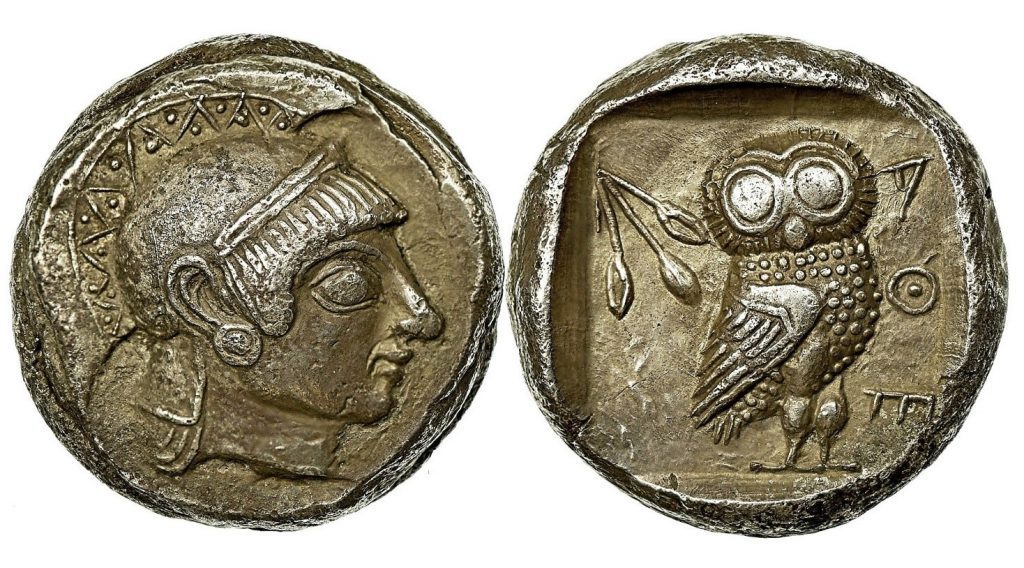

The mines in the Lavrion Mining District were opened in ancient times for their lead, copper and silver content. While the production of lead and silver from Lavrion is common knowledge, the inclusion of copper in this list may seem surprising, but Gale & Stos-Gale (1982) report: “Several lines of evidence suggest that the Laurion was one of a number of important sources of copper to the Bronze Age Aegean, including our lead isotope analyses. Our finding that Laurion copper was important for Crete harmonizes with our earlier finding that the Laurion was an important source of lead for Crete in the Bronze Age.” (cf. also O’Brien, 2015). In the 19th and 20th centuries the zinc, iron and manganese ores also became important.
Overview
The Neolithic and Bronze Age exploitation was rather small scale, the major area of exploitation was during the classical period, which is considered to begin with the uprising of the Ionian city states against their Persian-supported tyrants in 499 BC (Martin, 2013) until the death of Alexander the Great in 323 BC (Depuydt, 1997). During this time enormous advances were made in technological matters of mining, as well as in providing – for the first time ever – a legal framework to govern all aspects of mining. There is no doubt that the riches wrestled from the mines of Lavrion were decisive in creating and maintaining the fortunes of the city state of Athens, its cultural development, military might and establishing the “Owls of Athens” as the dominant and reference currency throughout the Mediterranean and adjacent areas.
With the depletion of the then known resources the mining industry went into a steep decline during the Hellenistic and Roman periods, interrupted by a short rekindling during the Byzantine era until the final abandonment in the 1st century AD (Migeotte, 2007).
With the “rediscovery” of the potential of Lavrion as a source for lead, zinc and silver in 1860, a new era of exploitation started that lasted until 1977 with the closure of the last mine, the North Mine in the Villia area.

Neolithic and Bronze Age
There are still ongoing discussions about the earliest period of mining in the Lavrion area. Xenophon wrote in 355 BC: “It is clear, I presume, to everyone that these mines have for a very long time been in active operation; at any rate no one will venture to fix the date at which they first began to be worked.”
Dating by various methods has shown that ceramics found in the famous underground “Mine Nr. 3” at Thorikos are from 3200 BC and shallow open-pit mining can be expected to have been active even earlier (Spitaels, 1984; Demoule and Perlès, 1993; Doctor and Van Liefferinge, 2010; Rosenthal et al., 2013; Van Liefferinge et al., 2014). Discoveries at the prehistoric site of Kephala (Κεφάλα) on the island of Kea (Κέα) of slags and burnt clay fragments of what is assumed to have been crucibles or furnaces show that copper was refined and processed there (Coleman, 1977). Although found outside a secure context, a piece of lead that was also discovered at Kephala has been linked to the silver-rich ores of Thorikos (Demoule & Perlès, 1993). The site of Kephala is only 24 km away from Lavrion as the crow flies, however, even though the small separation of the two places a direct visual contact is not possible, as the island of Makronisos (Μακρόνησος) lies between them.
In Thorikos evidence of lead and silver production was found dating as early as the Bronze age, too (Domergue, 2008). A large piece of litharge was dated from the very early Mycenaean period (16th century BC), which bears witness to the use of cupellation as a technique for the production of silver from the silver-bearing galena ores.
Greek Dark Ages (c. 1200 – c. 800 BC)
Cupellation as a means of silver production was continuously in use from its beginning, as pieces of litharge at Thorikos prove, which were also found among the artifacts (Domergue, 2008) from the relevant strata (11th century BC, which puts them in the Protogeometric Period). The dark ages were a times of decline and resulted in confining the mining operations to shallow open pit mining.
Archaic Period (c. 800 – 499 BC)

It is unclear when exactly the mines of Lavrion became property of Athens, but it is clear, that it came about during the Archaic Period. From around 600 BC we know that they already belonged to Athens, but only marginal profits were achieved. The Athenian lawmaker Solon codified mining laws in 593 BC (μεταλλευτικός νόμος) where the relations between the state and the lessee of the mines, the lease, security measures, and procedures to solve disputes were clearly put down. The solid legal basis made the mining interesting for investors and boosted effectiveness. The exploration and exploitation became more structured and systematic, leading to the discovery of Maroneia at the end of the Archaic Period (most likely around 520 BC; cf Picard, 2001). This was an important step insofar as this was the first time that sub-surface ores were mined. The discovery and subsequent mining show a clear understanding of the deposition of the metal-bearing solutions at the contact between the Lower Shale and the Lower Marble (the so-called “Third Contact”). Half a century later the city-state of Athens could rely on a steady income from mining.
